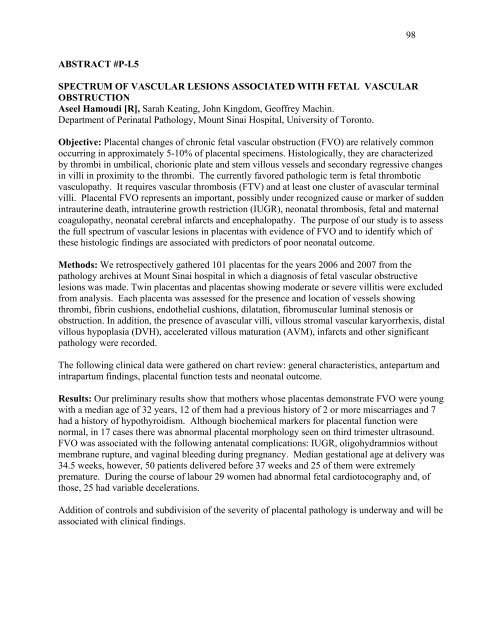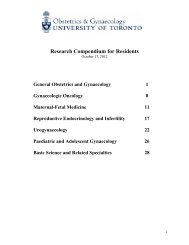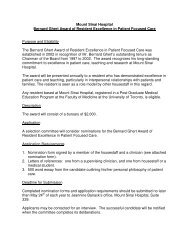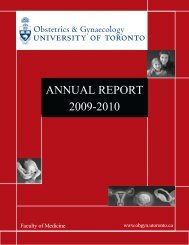research day - University of Toronto Department of Obstetrics and ...
research day - University of Toronto Department of Obstetrics and ...
research day - University of Toronto Department of Obstetrics and ...
You also want an ePaper? Increase the reach of your titles
YUMPU automatically turns print PDFs into web optimized ePapers that Google loves.
98<br />
ABSTRACT #P-L5<br />
SPECTRUM OF VASCULAR LESIONS ASSOCIATED WITH FETAL VASCULAR<br />
OBSTRUCTION<br />
Aseel Hamoudi [R], Sarah Keating, John Kingdom, Ge<strong>of</strong>frey Machin.<br />
<strong>Department</strong> <strong>of</strong> Perinatal Pathology, Mount Sinai Hospital, <strong>University</strong> <strong>of</strong> <strong>Toronto</strong>.<br />
Objective: Placental changes <strong>of</strong> chronic fetal vascular obstruction (FVO) are relatively common<br />
occurring in approximately 5-10% <strong>of</strong> placental specimens. Histologically, they are characterized<br />
by thrombi in umbilical, chorionic plate <strong>and</strong> stem villous vessels <strong>and</strong> secondary regressive changes<br />
in villi in proximity to the thrombi. The currently favored pathologic term is fetal thrombotic<br />
vasculopathy. It requires vascular thrombosis (FTV) <strong>and</strong> at least one cluster <strong>of</strong> avascular terminal<br />
villi. Placental FVO represents an important, possibly under recognized cause or marker <strong>of</strong> sudden<br />
intrauterine death, intrauterine growth restriction (IUGR), neonatal thrombosis, fetal <strong>and</strong> maternal<br />
coagulopathy, neonatal cerebral infarcts <strong>and</strong> encephalopathy. The purpose <strong>of</strong> our study is to assess<br />
the full spectrum <strong>of</strong> vascular lesions in placentas with evidence <strong>of</strong> FVO <strong>and</strong> to identify which <strong>of</strong><br />
these histologic findings are associated with predictors <strong>of</strong> poor neonatal outcome.<br />
Methods: We retrospectively gathered 101 placentas for the years 2006 <strong>and</strong> 2007 from the<br />
pathology archives at Mount Sinai hospital in which a diagnosis <strong>of</strong> fetal vascular obstructive<br />
lesions was made. Twin placentas <strong>and</strong> placentas showing moderate or severe villitis were excluded<br />
from analysis. Each placenta was assessed for the presence <strong>and</strong> location <strong>of</strong> vessels showing<br />
thrombi, fibrin cushions, endothelial cushions, dilatation, fibromuscular luminal stenosis or<br />
obstruction. In addition, the presence <strong>of</strong> avascular villi, villous stromal vascular karyorrhexis, distal<br />
villous hypoplasia (DVH), accelerated villous maturation (AVM), infarcts <strong>and</strong> other significant<br />
pathology were recorded.<br />
The following clinical data were gathered on chart review: general characteristics, antepartum <strong>and</strong><br />
intrapartum findings, placental function tests <strong>and</strong> neonatal outcome.<br />
Results: Our preliminary results show that mothers whose placentas demonstrate FVO were young<br />
with a median age <strong>of</strong> 32 years, 12 <strong>of</strong> them had a previous history <strong>of</strong> 2 or more miscarriages <strong>and</strong> 7<br />
had a history <strong>of</strong> hypothyroidism. Although biochemical markers for placental function were<br />
normal, in 17 cases there was abnormal placental morphology seen on third trimester ultrasound.<br />
FVO was associated with the following antenatal complications: IUGR, oligohydramnios without<br />
membrane rupture, <strong>and</strong> vaginal bleeding during pregnancy. Median gestational age at delivery was<br />
34.5 weeks, however, 50 patients delivered before 37 weeks <strong>and</strong> 25 <strong>of</strong> them were extremely<br />
premature. During the course <strong>of</strong> labour 29 women had abnormal fetal cardiotocography <strong>and</strong>, <strong>of</strong><br />
those, 25 had variable decelerations.<br />
Addition <strong>of</strong> controls <strong>and</strong> subdivision <strong>of</strong> the severity <strong>of</strong> placental pathology is underway <strong>and</strong> will be<br />
associated with clinical findings.

















